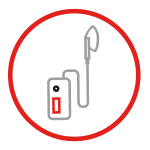If you suffer from obstructive sleep apnea (OSA) or even suspect that you do, you might just want to jump headfirst into the solution you hear about most often. The thing is, in order to understand which of the OSA treatment options is right for you, it's necessary to first diagnose what is causing the symptoms.
It's a common assumption that snoring is just a nasal issue, but it's more likely a throat issue. Either the tonsils are too big, the tongue is too big for the size of the back of the throat, or the palate is being elongated. Most folks have all these issues in play.
So, this is where treatment begins when you visit an ADVENT clinic. Everything starts with the nose first because if you can't breathe through your nose then it is most likely that the sleep apnea treatments won't work. Which is why we start with a thorough Breathing Triangle evaluation. This will determine if your airway is working properly -- meaning you can breathe the way you're supposed to...through your nose!
If it is determined that you have nasal airway blockage then your treatment plan will most likely start with an in-office procedure like balloon-sinuplasty or turbinate reduction. Balloon sinuplasty is a procedure that uses a three-millimeter balloon to open up your nasal passages, while turbinate reduction shrinks your turbinates giving your nose more room to move air. Once your airway is open then we get into the sleep apnea treatments.
If you have symptoms of sleep apnea or if your throat is too tight, you'll do an at-home sleep study to determine if you have OSA, and if you do, how severe it is.
Based on those results and the study of your anatomy, we can then layout a customized treatment plan for you and discuss your options.
Why A Breathing Triangle Evaluation for Sleep Apnea?
Why do we start with the nose first? Because sleep apnea devices do not work effectively if your airway is compromised in any way. Unfortunately, many sleep clinics skip this step which is why CPAP compliance nationwide is around 33%. But at ADVENT with our nasal first approach, we have a CPAP compliance rate of 88%!
Sleep Apnea Treatment Option #1: Oral Appliance

The first available option to treat sleep apnea symptoms at ADVENT is an oral appliance. This is basically a retainer that you wear while sleeping, fitting between your upper and lower teeth.
This device pulls your lower jaw forward, preventing your tongue from falling back and closing your airway. Most folks who are good candidates for a CPAP are also good candidates for an oral appliance. However, many people never hear of this option because most sleep centers don't offer this option.
Sleep Apnea Treatment Option #2: CPAP

The next and arguably most common option to treat sleep apnea symptoms is the CPAP machine. CPAP, which stands for Continuous Positive Airway Pressure, is a bedside machine that connects to a face mask with a hose and forces air into your nose and mouth.
The forced airflow puffs out your throat, much like when you puff out your cheeks, and tents open the areas that are collapsing while you sleep. But this machine will not work as it is designed if your nose is compromised in anyway.
Sleep Apnea Treatment Option #3: Procedures

And finally, there are various procedures to help treat the symptoms of OSA. The goal of these procedures is to either stiffen the tissue in the back of the throat or to remove the tissue blocking the airways.
OSA can be treated in most cases with a non-invasive solution like oral appliance or cpap.
One-Size-Fits-All Sleep Apnea Treatments
Some patients will find success with certain solutions, and others will not. And some will combine solutions, like using a CPAP and oral appliance together.
The thing is, there is no one-size-fits-all answer to treat OSA. If your nose isn't working properly, a CPAP or an oral appliance aren't going to magically solve your problem. However, it's helpful to have options. It's really about figuring out what the right option is for each individual.
When you connect your sleep study results with the diagnosis of your anatomy, it can point you in the right direction -- and most importantly, give you choices. Because we know, there is no one size fits all approach to treating sleep apnea. Ultimately, it's up to what you want...and now you know, you have options.


